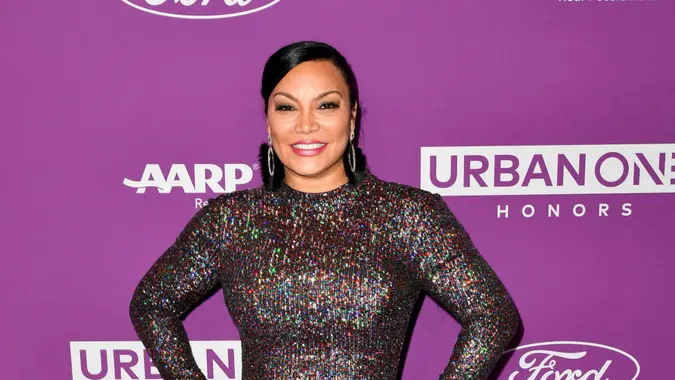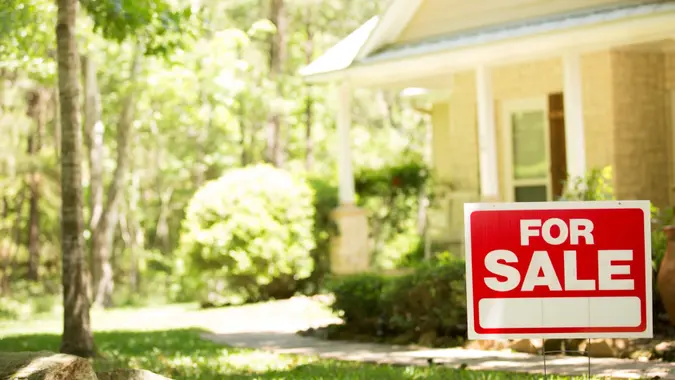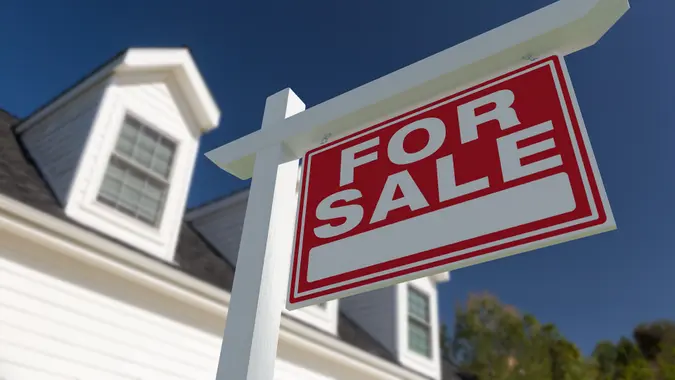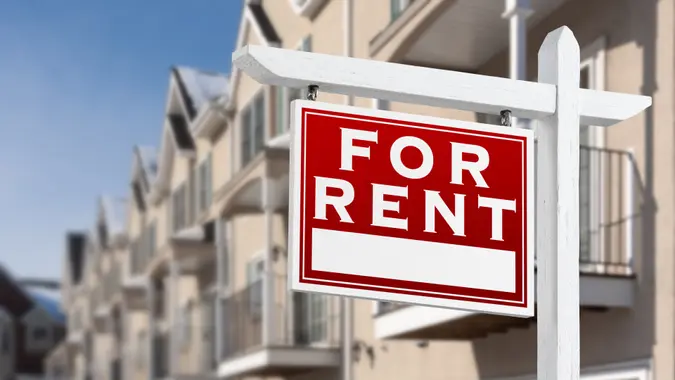What Does Homeowners Insurance Cover?

Commitment to Our Readers
GOBankingRates' editorial team is committed to bringing you unbiased reviews and information. We use data-driven methodologies to evaluate financial products and services - our reviews and ratings are not influenced by advertisers. You can read more about our editorial guidelines and our products and services review methodology.

20 Years
Helping You Live Richer

Reviewed
by Experts

Trusted by
Millions of Readers
Homeowners insurance offers property and personal liability protection for unexpected emergencies. Mortgage lenders require it, and it’s strongly advised in any event because of the financial protection it provides.
This guide explains how homeowners insurance works, what it covers and how to save money on your policy.
What Is Homeowners Insurance?
Homeowners insurance protects your home’s investment by reimbursing losses if your home or personal property is damaged or destroyed in a covered emergency. This is called a peril. It also covers personal liability if you, your pet or a member of your household accidentally injures someone or damages their property. The purpose of the insurance is to limit your out-of-pocket costs if an event like this occurs.
HO-3: The Most Common Homeowners Insurance Type
Insurers offer several standard homeowner policies. The most common one is an all-risk policy called HO-3 that covers a broad selection of emergencies affecting your home, and specific perils affecting your personal property. It also provides liability protection.
Think of homeowners insurance as a life jacket. You buy it knowing you might never use it. But if your boat sinks, it’s all that stands between you and disaster.
What Does Homeowners Insurance Cover?
A standard home insurance policy offers six categories of coverage. Here’s a summary of the coverage typically offered:
| Coverage Type | What It Covers | How It Protects You |
|---|---|---|
| Dwelling | Your home’s structure and anything built in or attached to the structure | If wind damages your roof, dwelling coverage will pay for the damage. |
| Other structures | Detached structures such as a garage, fence, shed, pool or playground equipment | This coverage would pay to repair a fence struck by a falling tree. |
| Personal property | The contents of your home and belongings you store elsewhere | Personal property coverage reimburses you for a bicycle stolen from your yard. |
| Loss of use | Additional living expenses if you’re displaced from your home | Loss of use coverage pays necessary expenses like lodging and meals while your home is being rebuilt after a fire. |
| Personal liability | Lawsuits stemming from you, a household member or pet injuring someone or damaging their property | If your dog bites a visitor and they sue you, liability coverage pays your legal expenses. |
| Medical coverage | Medical bills for the injured party | Medical payments coverage pays the injured party’s medical bills |
Each coverage category is subject to limits that vary by policy.
What Does Homeowners Insurance Not Cover?
Homeowners insurance is meant for sudden, unexpected events, so it doesn’t cover damage from neglect or wear and tear. It also won’t cover earthquakes or weather-related floods. You’ll need separate insurance for those risks.
Other exclusions include:
- War
- Nuclear accidents
- Landslides
- Mudslides
- Sinkholes
- Settling soil
- Power failure caused by a noncovered peril
- Pollution
- Water backup from sewers or sump pumps
- Mold resulting from a non-covered peril
How Do Exclusions Work?
Imagine that an explosion damages your foundation. Your insurance would cover it because explosions are covered perils. But what if the damaged was caused by a longstanding drainage problem you neglected to repair? Insurance excludes delayed maintenance and other forms of negligence, so you’d have to pay for the repair out of pocket.
Power failures are another good example. If equipment failure at your power company causes a surge that burns out your refrigerator, you’ll have to replace it yourself. But if the surge is caused by a covered event like a falling tree or lightning strike, insurance would cover at least part of the cost.
What Does Homeowners Insurance Cover and Not Cover?
Standard homeowners insurance covers all perils except those that are specifically excluded. Here’s a side-by-side look at some of what a policy covers and what it doesn’t, per the Insurance Information Institute.
| Covered Perils | Excluded Perils |
|---|---|
| Fire and/or lightning | Floods |
| Windstorm and/or hail | Earthquakes |
| Explosion | Wear and tear |
| Riot or civil commotion | Intentional acts |
| Damage from aircraft | Negligence |
| Damage from vehicles | |
| Smoke | |
| Vandalism and/or malicious mischief | |
| Theft | |
| Volcanic eruption | |
| Falling objects | |
| Weight of ice, snow or sleet | |
| Accidental discharge or overflow of water from plumbing, HVAC, fire sprinklers or home appliances | |
| Sudden, accidental cracking, burning, tearing or bulging of steam or hot water HVAC or fire safety equipment | |
| Freezing of plumbing, HVAC or fire sprinkler | |
| Sudden, accidental discharge from artificially generated electrical current |
The coverages and exclusions listed above pertain to dwelling coverage. Less-common policy types cover fewer perils, as does the personal property portion of even standard home insurance policies. It’s a good idea to review your policy every year to avoid having an exclusion catch you off-guard.
Surprising Things Homeowners Insurance Covers
Believe it or not, your homeowners insurance might cover a meteorite hitting your house. Meteor strikes are rare, but they count as falling objects, which are a covered peril. Here are some other surprising things homeowners insurance might cover, whether as part of standard policy or as an add-on, as long as they’re caused by a covered event.
- Dog bites, unless the breed is excluded
- Spoiled food from a storm-damaged refrigerator
- Identify theft
- Theft or vandalism of belongings in a storage facility
- Damage to your landscaping
- Theft or damage of items your child keeps in their dorm
- Damage from large wild animals like deer and bears, or escaped farm animals like cattle
- Upgrades to modernize your older home as part of a covered repair or rebuild
- Accidental injuries or property damage you cause while away from home
- Tornado damage
Optional Coverages and Endorsements
You can add optional riders and endorsements to your policy to customize and expand your coverage. See the costs and benefits in the table below.
| Coverage | Cost | Benefit |
|---|---|---|
| Scheduled property | Approximately 1% of coverage amount | Increases coverage on jewelry, furs, collectibles, electronics, art and other expensive appraised items. Can consist of blanket coverage or coverage for specific items. |
| Earthquake | Up to 1% of coverage amount | Adds earthquakes to covered perils |
| Sinkhole | Varies by location | Covers damage resulting from sinkhole or ground collapse. In Florida and Tennessee, home insurers must make sinkhole insurance available. |
| Water backup | 1% of coverage limit | Expands water damage coverage to include drain, sewer and sump-pump backups |
| Identity theft | $40-$45, on average | Pays for losses resulting from theft of your personal information |
| Green improvements | Starts at 1% of premium for partial replacement cost | Lets you replace damaged or lost property with more energy-efficient versions |
| Short-term rentals | From approx. $500 to several thousand dollars, depending on property and location | Covers damage and liability while your home is rented to short-term guests |
Another way to expand your coverage is to insure your home’s contents for replacement value rather than cash value. Cash value represents depreciated value, which might not cover the cost of replacement.
These optional coverages can fill gaps in your policy — ask your insurer about what’s available.
How To Save Money on Homeowners Insurance
In 2025, the average annual premium is $2,532 according to data from Insurify. These tips will help you get the most value for your money:
- Improve your credit: Your premium is based in part on your insurance score, which represents your risk of filing a claim.
- Reduce risk: Add or update safety equipment such as smoke detectors and home security devices, and avoid dangerous equipment like trampolines.
- Review your deductible: A higher deductible can reduce your insurance premiums. Consider opening a savings account with the amount of your deductible to guarantee you’ll have the cash on hand in the event you need to file a claim.
- Bundle your policies: Purchasing home and auto insurance from the same company can earn you a discount of up to 25%, per quote data from Compare.com.
- Shop around: Compare companies, rates and coverages to look for the best deal.
Quick Reference: Homeowners Insurance Coverage Table
Here’s a quick summary of homeowners insurance coverages, coverage limits and common misconceptions.
| Coverage Type | What It Covers and Misconceptions | Typical Coverage Limit* |
|---|---|---|
| Dwelling | – House, attached structures – Misconception: It covers wear and tear. |
Replacement value |
| Other structures | – Detached structures. – Misconception: Neighbor’s insurance pays if their tree falls on my fence. |
10% of dwelling coverage |
| Personal property | -Contents of house and other belongings – Misconception: Jewelry, collectibles are covered at full value. |
50% to 70% of dwelling coverage; valuables limited to about $2,000 |
| Loss of use | – Additional living expenses if displaced – Misconception: It covers lost home-business earnings. |
20% of dwelling coverage |
| Personal liability | – Lawsuits for injury or damage you cause – Misconception: All dog breeds are covered. |
$100,000 and up |
| Medical coverage | – Medical bills for the injured party – Misconception: It pays insured individual’s medical bills. |
$100,000 |
Barri Segal contributed to the reporting for this article.
FAQs About Homeowners Insurance
Still have lingering questions about homeowners insurance? Find more answers below.- Can I customize my homeowners insurance policy?
- Yes. You can customize your policy by selecting coverage limits and deductibles, and by adding endorsements and riders to fill gaps in coverage.
- What happens if my home's value increases?
- Increased home value, whether because of local market conditions or value-adding home renovations, could leave you underinsured. Review your policy every year to ensure you have enough coverage.
- Does homeowners insurance cover home-based businesses?
- Yes. It provides limited coverage for equipment and perhaps liability protection. Consider purchasing an endorsement or business insurance to ensure your business is fully protected.
- What should I do if my claim is denied?
- If your claim is denied, appeal the decision, and provide as much evidence as possible to support your claim. If that doesn't work, contact your state's insurance department to find out if. If not, or if the company again denies your claim, but you still believe it's legitimate, seek legal advice.
- How often should I review my homeowners insurance policy?
- It's a good idea to review it once per year to ensure you have enough coverage -- but aren't paying for coverage you don't need.
Our in-house research team and on-site financial experts work together to create content that’s accurate, impartial, and up to date. We fact-check every single statistic, quote and fact using trusted primary resources to make sure the information we provide is correct. You can learn more about GOBankingRates’ processes and standards in our editorial policy.
- Insurance Information Institute (III). 2025. "What Is Homeowners Insurance?"
- National Association of Insurance Commissioners. 2025. "NAIC Releases Homeowners Insurance Report for 2022."
- Kin. 2024. "Home insurance and power outages: What’s covered?"
- III. 2025. "Homeowners insurance basics."
- Insurify. 2025. "What Is an HO-3 Homeowners Insurance Policy?"
- Progressive. 2025. "Does home insurance cover wild animal damage?"
- Policygenius. 2025. "What is scheduled personal property coverage?"
 Written by
Written by  Edited by
Edited by 

























